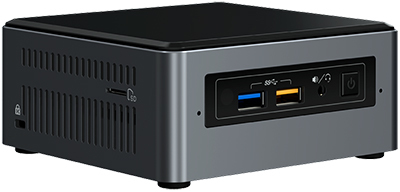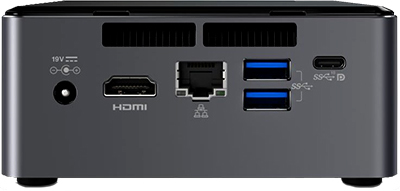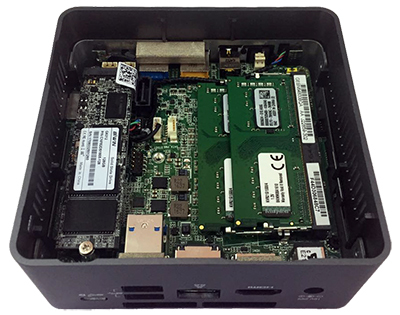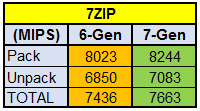In recent years, the formats of interaction between people have undergone dramatic changes, becoming deeper and more diverse. This was largely due to the emergence of the latest video technologies, which allow us to achieve a new quality of communication. 4K Ultra High-Definition, 360º panoramic video and virtual reality technologies have dramatically expanded our capabilities.
Today's trends in the consumption and creation of content through interpersonal communication and interaction with each other reflect what we at Intel call the Immersive Internet. virtual reality or immersive Internet ( immersive internet). Use all opportunities, etc.
The immersive Internet enables high-performance computers to create the most realistic experiences possible. People need powerful tools to watch, create, and play—which is what the personal computer was created for.
And today I am pleased to introduce new 7th Gen Intel® Core™ processors, tools that enable you to create experiences. The new generation of processors, designed specifically for the immersive Internet, leverages Intel's deep expertise in high-performance solutions and delivers unprecedented capabilities for working with new media technologies.
Seventh generation Intel Core processors are innovative in many ways:
High speed of operation and response: Intel's processor design and manufacturing team has managed to extract even more power from our 14nm technological process, realizing what we call 14nm+. Compared to the previous generation of processors released just a year ago, Intel processors Core 7th generation allows you to achieve an increase in productivity up to 12%, and up to 19% in Internet productivity.
Ability to view high-quality content in 4 formatK UHD: With new PCs powered by 7th Gen Intel Core processors, TV and movie lovers will be able to stream premium 4K UHD content from studios like Sony Pictures Home Entertainment or online services like Fandango. And this is just the beginning - over time, 4K UHD content is becoming more widespread. We're excited to make a number of new announcements about the availability of additional content over the next few months, so stay tuned.
New world of user-generated content 4K UHD: With the advent of computers powered by 7th generation Intel Core processors, people can watch 4K UHD content on places like YouTube, and the videos themselves can be longer. But at the same time, you'll be able to create, edit, and share 4K UHD and 360º videos yourself, all 15 times faster than on a 5-year-old PC—all thanks to innovation. in the new media coprocessor.
Games on the go: For gamers, the new generation of processors delivers up to three times the graphics performance of PCs released 5 years ago, meaning users can now enjoy popular games like Overwatch™ anytime, anywhere on a thin and light laptop. And with more devices supporting Thunderbolt 3 technology, gamers can use a single cable to connect an external graphics card and 4K UHD monitors for maximum gaming performance.
Application in the thinnest and lightest devices: just compare the products on the market today with computers from five years ago and see the progress. New laptop models based on 7th processors Intel generation Cores can be thinner than phones and still deliver full desktop performance!
We are excited about our strong partnership with our OEM customers and expect to see more than a hundred new 2-in-1 devices and laptops powered by 7th generation Intel Core processors coming to market between September and the holiday season. Learn more about Intel family processors Core new generation for desktop computers and corporate PCs, we plan to tell you early next year.
We're truly excited to introduce our new family of 7th Generation Intel Core processors. In my opinion, now is the best time to get acquainted with what we are capable of personal computers based on new Intel processors.
Intel is a sponsor and participant in the BenchmarkXPRT Development Community and served as the primary developer of the XPRT family of benchmarks. Principled Technologies* is the publisher of the XPRT family of tests. Other information and other performance tests must be used to make a purchasing decision.
System configurations:
System configurations based on 7th generation processors:
Intel® CRB, Intel® Core™ i5-7200U processor, PL1=15W TDP, 2C4T, Turbo up to 3.1 GHz, memory: 2x4GB DDR4-2133, storage subsystem: Intel SSD, screen resolution: 1920x1080. Intel HD, Graphics 620, operating system: Windows* 10 TH2
Intel® CRB, processor Intel® Core™ i7-7500U, PL1=15W TDP, 2C4T, Turbo up to 3.5 GHz, memory: 2x4GB DDR4-2133, storage subsystem: Intel SSD, screen resolution: 1920x1080, Intel HD Graphics 620, operating system: Windows* 10 TH2
System configurations based on 6th generation processors:
Intel® CRB, Intel® Core™ i7-6500U processor, PL1=15W TDP, 2C4T, Turbo up to 3.1GHz, memory: 2x4GB DDR4-2133, storage subsystem: Intel SSD, screen resolution: 1920x1080. Graphics Driver: 15.40.4254, Operating System: Windows* 10 TH2
A comparison was made with the following system:
Intel® Core™ i5-2467M Processor (1.6 GHz Base, Up to 2.3 GHz, 2C4T, 17W TDP) in Dell* XPS13-40002sLV 13” Ultrabook, RAM: 4GB DDR3, Storage: 128GB SSD, Screen : 13.3” with a resolution of 1366×768, battery: 46Wh, operating system: Windows* 7
Descriptions of work tasks:
SYSmark* 2014 is a benchmark suite developed by the BAPCo* consortium to evaluate the performance of Windows*-based platforms. SYSmark tests cover three use cases: office productivity, media content creation productivity, and data analytics/financial information productivity. SYSmark includes real applications from independent vendors software such as Microsoft* and Adobe*. Published results: SYSmark 2014 Rating and results in each use case (the higher the better). Efficiency scaling: depends on the CPU, frequency, number of cores and memory. QSV support included.
WebXPRT* 2015 is a test developed by Principled Technologies* to evaluate the performance of web applications in six different use cases: working with photos, organizing albums, local notes, viewing quotes, working with sales charts, and viewing DNA sequences. WebXPRT tests the performance of technologies used in modern browsers, including HTML5 Canvas 2D, HTML5 Table, HTML5 Local Storage, and JavaScript work*. Published metrics: operation time (lower is better) for each scenario, plus overall score (higher is better). Efficiency scaling: CPU dependent (newer browsers use hardware graphics accelerators), and on the frequency of operation. WebXPRT test results can vary greatly depending on the browser type and version. Operating system support: any operating system with a browser that supports HTML5.
3DMark* is a Futuremark* test that evaluates the gaming performance of DX* 9 / OpenGL* ES 2.0, DX 10 and DX 11. The package includes three main tests: “Ice Storm” for DX 9 / OpenGL ES 2.0, “ Cloud Gate" for DX 10, "Sky Diver" for DX11 and "Fire Strike" for DX 11. Published metrics: Graphics Score (GPU), Physics Score (CPU), Combined Score, GPU & CPU) and overall 3DMark Score (for all indicators, the higher the better). Scaling efficiency: results graphics tests depend on the graphics coprocessor, graphics and central processor operating frequencies, number of cores and memory size. Operating systems supported: Windows* for desktop platforms, Android*, iOS* and Windows RT.
MAGIX Fastcut video content creation test: using the MAGIX* Fastcut package, source video 9 minutes 21 seconds long at 3840x2106 resolution, ~59.9MBit/s, 30fps, H.264, 3.89GB, .mp4 file. The “A Cold Place” template was applied and the video was exported with UHD settings. Output video parameters: 38 seconds, 3840×2160, ~59MBit/s, H.264, .mp4 file.
Compact mini PCs Intel based NUC for Lately have found wide application in various IT areas. High-performance Intel Core i3/i5/i7 processors combined with a miniature form factor allow you to use such devices as home or office computer, client terminal or specialized multimedia device. For example, our company is based Intel NUC built a line of software terminals for video conferencing. We talked about using these terminals in the article "".
And then it appeared new line mini-devices based mobile processors 7th generation Intel Core. The price is similar to the 6th generation, the characteristics at first glance are almost identical.
In order to understand the distinctive features and advantages of the new platform, a number of standard tests were carried out, the results of which are given below the cut.
Review
The younger model NUC7i3BNH based on Intel Core i3-7100U was chosen for review.There are 2 form factors for i3/i5 platforms:
- a very thin case without a 2.5" bay for HDD or SSD (with the letter “K” at the end of the kit name);

- and, as in our case, the model with installed M.2 SSD 128Gb + 2.5" HDD 1Tb (with the letter “H” at the end of the kit name) is 16 mm higher.

Differences in design from the sixth generation NUC are immediately noticeable - the power button has been moved from the top cover to the front panel (probably to make it more convenient to place NUCs on top of each other), the disk activity indicator has turned into a thin frame around the front panel connectors, a full-size slot for The SD card on the side has been replaced with a smaller microSD option.

The rear panel of the case has also undergone changes. 10Gbps appeared USB connector 3.1 Gen 2 (aka USB Type-C, aka USB-C), which can be used as a Mini DisplayPort 1.2. The power connector of the new platform is now in line and too close to HDMI, which causes significant difficulties when connecting a video cable through a DVI-HDMI adapter.
To access the inside and install RAM and storage, the Intel NUC case is disassembled from the bottom. In our case, in this model, behind the bottom cover there is a basket with an installed 2.5" Seagate Barracuda 1Tb hard drive.


The platform supports the installation of two DDR4 SO-DIMM memory modules and one M.2 SSD drive, and there is also an internal 2 x USB 2.0 connector. Besides all this, there are no other internal free connectors in this model.
The package includes a VESA mount that allows you to attach the NUC to the back of the monitor or mount it on the wall.
Comparison, testing
The seventh generation of Intel NUC did not bring anything fundamentally new. From the comparison table of Intel Core i3-6100U and i3-7100U processors, highlighting the differences, it is clear that the main changes were: a new graphics core and an increased (by 0.1 GHz) clock frequency.To compare the performance of the “new” and “old” systems, two similar configurations of the 6th and 7th generations of Intel NUC were tested in available common benchmarks.

The comprehensive PerformanceTest 9.0 benchmark showed a consistent slight advantage for the new generation. But, given the processor frequency increased by 100 MHz, this is understandable - if you divide the results by frequency, you get almost the same values in the processor and memory tests. But in graphics performance tests, the results were slightly higher, even taking into account the frequency.
Since many people use the NUC as a home PC, and often even play on it, the results of the 3DMARK gaming graphics benchmark will be appropriate.

3DMARK has several different tests for systems of varying performance - starting with mobile devices, and ending with gaming PCs with two top-end video cards. It seemed reasonable to run only the middle options, that is, everything except the first and last.
Advantage of Intel HD Graphics 620 over 520 in PC tests entry level very significant. But as the load increases, the advantage gradually decreases. In any case, the performance of integrated graphics, IMHO, has achieved significant results today, which makes it possible to use a mini-PC for most tasks, including those related to video or graphics.
Also, just for fun, testing was carried out in CINEBENCH and 7ZIP.


In these tests, the performance gain of the new generation platform is so insignificant that when converting the results into a parrots per gigahertz ratio, you can even see a slight drop in the performance of the Intel NUC 7-Gen versus 6-Gen.
conclusions
In fact, no advantages of the Kaby Lake architecture over Skylake have been found - we will wait for a change in the technical process, maybe the advantages will appear. Perhaps, to show at least some increase in performance, this 1/10 gigahertz was added to the processor frequency.A comparison of Intel HD Graphics 620 versus Intel HD Graphics 520 also revealed a not very noticeable advantage.
Based on this, there seems to be little point in deliberately changing the 6th generation NUC to the 7th.
But if you have to buy a new PC, then, of course, it is better to give preference to a more recent model. Plus it costs the same. Actually, that's exactly how it works.
Thank you for your attention!
7th generation Intel Core processor die
Microsoft is actively promoting its latest operating system, Windows 10. Initially an optional update, it later began. At the beginning of January Microsoft company reported that the new processors Intel Kaby Lake, Qualcomm 8996 and AMD Bristol Ridge will only be supported by the Windows 10 operating system. Processor manufacturers have now confirmed this information.
“After the release of the new generation of chips, they will only work in the latest Windows platform,” said a Microsoft spokesman. “This allows us to focus on deep integration between Windows and new chips, ensuring maximum reliability and compatibility with previous generations of processors.” So those users who were hoping to build a powerful machine based on new processors and work with a familiar OS will most likely not be able to do this.
Microsoft's policy suggests that the latest generations of processors should support only one Windows - Windows 10. As for AMD and Intel, these companies do not have much big choice. They can either work with Microsoft on its terms or refuse to cooperate. Microsoft partners chose the first option. These companies responded to Pcworld's request, confirming their intention to submit to the will of the corporation.
"We reaffirm our commitment to working with Microsoft and our partners to comply with Microsoft's policy changes," an Intel spokesperson said. He also stated that the company will not release a version of the 7th generation Intel Core processor drivers for Windows 7/8.
AMD representatives said roughly the same thing: “Development roadmap AMD processors aligns with Microsoft's software strategy." In June, the company released the Bristol Ridge chip, which is also a seventh-generation processor. And the first representative of the Zen microprocessor family will appear in powerful desktops early next year. This processor is called Summit Ridge. Windows support AMD does not list 7/8 for these processors.
It's unclear what will happen if you try to run previous versions Windows OS on a PC or laptop with the latest processor. As experts say, previous versions of Windows OS will work without an official driver, but the work will be unstable - glitches and failures are possible. Some of the specific functions that are supported by new generation processors will not work at all. In this regard, OS freezes, unauthorized reboots and crashes are possible. operating system at the most unexpected moments.
A number of experts disagree with this statement. For example, Dean McCarron from Mercury Research believes that there will be no problems with the new processors. “Most likely, third-party companies will release their own drivers, which will allow it to work without any problems,” he says. McCarron says that for regular user minor problems may not be noticeable. There was a glitch, and that's okay.
Corporate users are a completely different matter. Third-party chipset drivers do not guarantee reliable operation of the computer system. Here the slightest failure can result in millions of losses. Therefore, such users will likely have to either risk money and the stability of their services, or agree to Microsoft's terms and update the OS. And this, in turn, creates additional problems for companies whose software platforms may be “tailored” for older versions of Windows OS. The transition to Windows 10 for such companies also involves time and financial costs.
True, corporate users with computer systems on the sixth generation Skylake platform, Windows 7 and Windows 8.1 updates. The period of support is limited to 18 months. Systems that will receive the update include: Dell Latitude 12, Latitude 13 7000 Ultrabook and XPS 13, HP EliteBook Folio, EliteBook 1040 G3, and Lenovo ThinkPad T460s, X1 Carbon and P70.
As we can see, Microsoft Corporation is making very significant efforts to convince users of its software platform Go to new version OS. And the fact that the company was able to agree on cooperation with processor manufacturers speaks volumes. It is likely that in the near future Microsoft will still be able to persuade users (both corporate and ordinary) to update their operating system.
Dynamics of growth of the market share of Windows 10 and others Windows versions over the last three months:
Windows 10 may be delivered through an Operations as a Service model. Now, according to corporation employees, the development of new versions of the operating Windows systems not being carried out. Previously, this was almost always the case. For example, when Windows development 8, work was also being done on Windows 10. Now, Microsoft divisions are only working on improving Windows 10, releasing regular improvements and updates. Large volumes of new features are added in the form of major updates. For example, significant Windows update 10 - Anniversary Update. Most likely, this operating principle will continue to be maintained, with the addition of new modules to the existing OS. If this is indeed the case, it makes sense why Microsoft is so concerned about getting users to switch to Windows 10.




